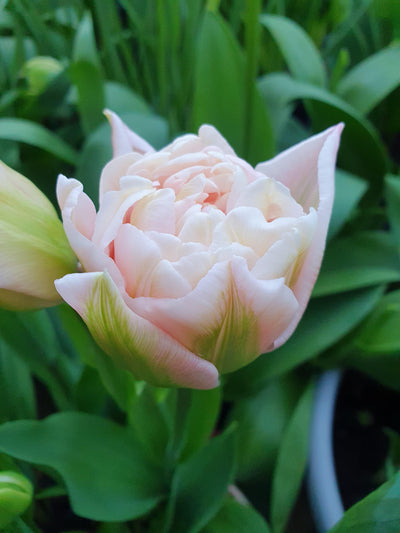Gardening for Wildlife by Alex Pettitt
Alex has kindly shared his tips to make your garden better for wildlife. I hope you find this helpful and interesting.
The Greek proverb ‘A society grows great when old men plant trees whose shade they will never sit’, or a paraphrased version, is often used when discussing gardening for wildlife and the virtuosity of ‘rewilding’ your garden. The saying, when applied to your garden, suggests that opening your outdoor space to nature is an act that you will never see the fruits of; perhaps your children or their children may reap the benefits, but you are left with the toil of making it happen. While this is true to a degree, the results of gardening for wildlife can be apparent sooner, the reward for your labour more immediate and gratifying than generational payback.
Anyone who has inherited a black canvas of a garden when moving into a property will know the astonishing speed at which life returns once nectar-rich floral beds or pots have been added to the space. Bees, butterflies, Damselflies, and other beneficial flying insects are the most obvious; a charming robin may well already have popped by to see if there are any juicy morsels to forage for as you plant up a border. As much as I love plants for their majesty and variety, after all they are the stars of the show, very little compares to the magic created by a garden brim-full of life for you to observe as you sit with a morning coffee or tea.

Figure 1 Bumblebee finding nectar on an Helenium 'Zimbelstern'
There are a number of methods to garden for wildlife, to help cut through what can be a complex topic I have created a series of writings on different areas for an aspiring wildlife gardener to use as a toolbox to create your own haven for all creatures. These range from introducing water features to creating nesting and hibernation features for a whole host of animals; firstly, we will discuss the headliners, the plants:
Plants, particularly flowering perennials, and shrubs are the most obvious way of measuring the success of the wildlife value of your garden; the difference of a couple of warms weeks in spring for the population sizes of pollinators is stark. However, there are methods to fine tune your floral displays to provide food sources for longer periods of the year. Planning your planting selection to provide flowers continuously throughout the year, also called a floristic relay, means your garden has sources of nectar all-year round – the upshot of this is your garden remains colourful even in the gloomier months as well as giving your outdoor space different characteristics and feels at different stages of the year. It may well feel overwhelming as to where to begin with orchestrating a grand floral symphony, but there are simple ways to break down what to look for when starting out.
Spring
Spring is shown into the year by bulbs, Snowdrops into Daffodils into Fritillaries into Crocuses into late spring and summer with Alliums and many more. There are many glorious flowering shrubs that work their magic in the earlier months of the year; any fans of the Japanese garden style will be familiar with the beauty of Camellias, Pieris, and Rhododendrons during spring. Early spring flowering perennials can be incorporated to the latter half of the season to bring your planting into the summer months; RHS Chelsea Flower Show is (usually) resplendent with these plants, such as Lupins, Snapdragons, and Irises.

Figure 2 Crocus providing early season colour & nectar
Spring is the season of rebirth for many things, many animals are coming out of hibernation or have produced a new clutch of younglings, therefore providing rich sources of food is essential. While having a floristic relay of bulbs and other spring flowers is fantastic for pollinators, there are a host of other creatures that need alternative food sources from your garden. Caterpillars, slugs, and snails all require leafy greens to grow, so providing and giving some of them over as food is hugely beneficial to your garden as a whole ecosystem. Brassica and Hosta growers may well be spitting out their coffee or tea after reading that last line but consider the new avian parents nesting in the trees or hedges in your garden; a juicy caterpillar or slug is the perfect thing to feed to their offspring. While it can seem counter intuitive as a gardener, but it is highly valuable to marry aesthetic value with the ecological function of your garden and embrace these ‘pests’ to enable the more desirable wildlife to create a viable home in your home.
Summer
Summer brings a whole host of possibilities for floral borders, with foxgloves making their first appearances; Alliums continuing through from late spring; and Roses adding elegance to proceedings. Summer can almost be broken up into two sub-seasons, the first half is the classic summer display of traditional garden favourites, while the second half of the season is characterised with the appearance of the North American prairie daisies; Rudbeckias, Echinaceas, and Asters among many others provide that continuation of summer through to the coldest months of the year. There are some more bulbs that can be added to the lasagne for this season, with Gladiolus and Eremurus both flowering during this period, adding height and drama to the mid-back border with their striking flower spikes. During this period, the shrub and tree layer of your garden can simply be providing interesting leaf texture and height to the border. There is almost no need for any flowering shrubs at this point due to the abundance of colour of the herbaceous plants, the branches also give room to foraging or nesting birds. Shrubs in particular can provide the perfect foil to all of the flowers on display; a patch of green can provide a break for the eye, as well as reducing the risk of too many plants clashing in a Pollock-esque kaleidoscope of colour. Mahonia, Witchazel and Dogwood are excellent examples of shrubs that provide texture and a green canvas during the peak garden moths, while bringing something special during the winter; Witchazels in particular provide the most dramatic structure for your border, with their fantastic vase shape form and welcoming broad, green leaves.

Figure 3 Dan Pearson Studio’s prairie style border at Gasholder Park, Kings Cross
During this period, consider the life cycles of your target species – insects such as butterflies require leafy material to lay eggs on, which double as a food source for their larvae. In a natural landscape in the UK, nettles would provide that service, if you are not ready to invite those into your garden, more ornamental plants such as Lamium provide a reasonable alternative. Problems such as these demonstrate that wildlife gardening can be somewhat a compromise, however there is rarely a situation where aesthetic value cannot be achieved, sometimes it takes a little research and a dash of creativity!
Autumn
As mentioned, the North American daisies can extend the summer floral season through autumn before delivering you and your garden to Christmas’s door. When paired with an ornamental grass matrix - a style of planting that uses few species of grass distributed throughout the scheme in large numbers – the daisies create a wonderful goodbye to the warmer months. Furthermore, by incorporating grasses among the flowers, you will create the warmest of autumn displays. Grasses such as Molinia, Deschampsia and Miscanthus throw up seed heads providing glorious textures and colours; as the cold sets in, the leaves of these plants turn a beautiful array of golden hues, if you throw a Liquidambar, Parrotia, or Rhus into the mix, then you have the perfect ingredients for a ‘pumpkin-spice’ autumn aesthetic for your garden.

Figure 4 Seed heads and golden grasses provide texture and muted autumnal colours (apart from the punchy asters!) in Tom Stuart-Smith's Paradise Garden at RHS Bridgewater
The seeds heads of both the grasses and coneflowers create a rich source of foraging for a number of wildlife species too, with birds and small mammals finding some late year food sources prior to nesting or hibernation. Autumn is also the season of berries and fruit! Even if you have a small garden, there is room for a fruit tree; varieties of apples and cherries, such as ‘Evereste’ or ‘Morello’ can serve both you and the creatures in your garden, try leaving some of the windfall fruit for foragers. There is a litany of fruits available to plant in your garden: Apples, Pears, Plumbs, Crabapples and Cherries are a staple; Medlars, Gages and Mulberries are the somewhat forgotten treasures; Filberts, Cobs, Hazels, and Walnuts shouldn’t be ruled out just because they are nuts; and Quinces (Cydonia or Chaenomeles), Persimmons, and Pomegranates provide something exotic and fascinating. Those are just the conventional fruiting trees and large shrubs; Rosehips, Blackberries, Sloes, Haws, and many other fruits can be found on smaller plants to enable you to fill your garden with produce for you and your wild creatures. Many of these fruits will stay on the branch long into winter, blending the two seasons together seamlessly.
Winter
The decision to select muted summer shrubs will pay-off in bucketfuls during the winter; the aforementioned trio of Witchazel, dogwood and mahonia provide a real spark in this season, with scented flowers, bright stems, and fruit the name of the game. The Witchazel family of plants, Hamamelis, Fothergilla and Parrotia, lift wintery gardens with fragrance from unfussy flowers close to the stems; paired with Sarcoccoca, the witchhazels can create a playful winter scent garden, with it not always being visually obvious where the fragrance is coming from. These shrubs, while being fantastic for the owner of the garden, provide a fantastic source of nectar for insects in a season that is devoid of the floral abundance of the rest of the year. The layers beneath these shrubs can be bolstered by the clever use of winter bulbs and corms; Winter Aconites and Cyclamen both flower throughout the winter months in a shaded part of your garden, carrying your bulb calendar through to the first snowdrops and crocuses in early spring.

Figure 5 Mahonia berries clinging on after snowfall, a valuable food source in winter
It is possible to form groups of plants that provide seasonal colour in conjunction with each other, which can create a completely individual character within your garden. The spring version of your garden can look and feel very different from your autumn garden; the poetic and romantic nature of an ever-changing tapestry is garden entertainment in itself. By allowing some seed heads to stay in your garden rather than mowing them at the first sign of decay, some plants will migrate around your garden, further exemplifying the notion of an ever changing and ever evolving space. Your garden can become emblematic of life itself; everchanging, evolving and finding a natural rhythm. A less-controlled garden can provide the user a low-key form of therapy, plants new to the year during each season can nourish the mind of the viewer, seemingly forming a character with its own narrative during that season. Furthermore, by providing the hibernation or nesting structures for wild creatures in your garden, this rhythmic planting in your garden can provide bountiful food sources, so much so you may find that you no longer need to use bird seed feeders or other artificial feeding stations while still attracting huge numbers of garden birds, small mammals, or balletic flying insects. Hibernaculas, nesting structures and other features will have to wait for another release, however, keep your eyes peeled for more on gardening for wildlife!





Leave a comment